What Part of the Car Does the Law Require You to Keep in Good Condition in the UK?
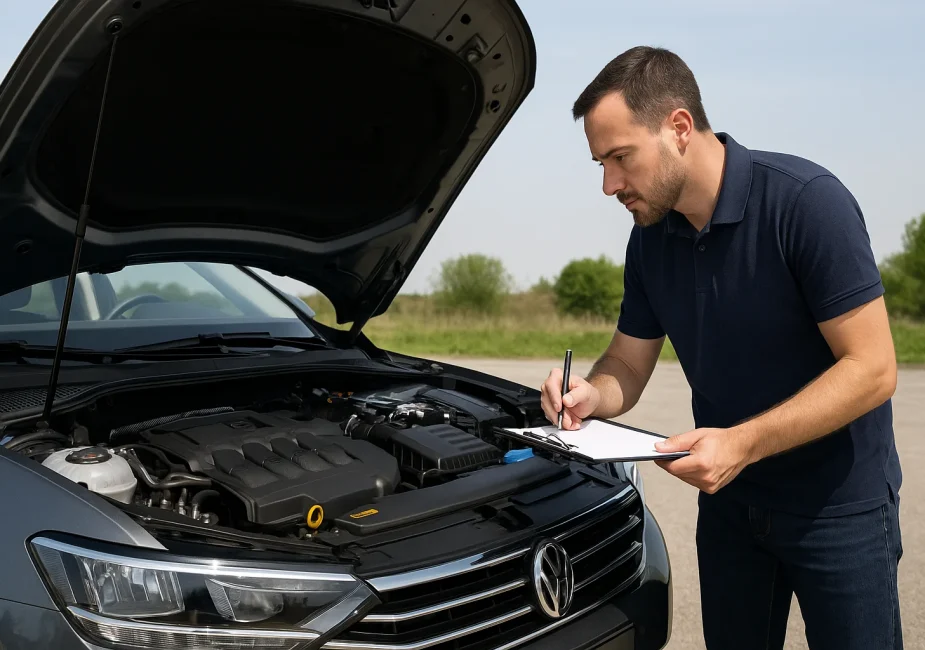
In the UK, driving a vehicle that is not roadworthy can lead to serious legal consequences and put lives at risk. Laws are in place to ensure vehicles meet essential safety standards.
As a driver, you are legally required to maintain key components of your car to avoid fines, penalty points, or worse, accidents. From tyres to seat belts, every detail matters when it comes to road safety.
This article explains which car parts must be legally kept in good condition and how to ensure your vehicle remains compliant and safe at all times.
Why Is It Important to Keep Your Car in a Roadworthy Condition?
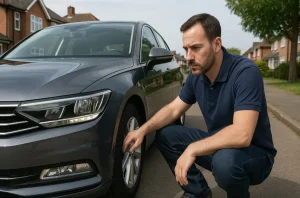
Keeping your car in a roadworthy condition is essential for ensuring safety, reliability, and compliance with the law. It goes beyond simply passing the annual MOT test, it’s about maintaining a vehicle that protects you, your passengers, and other road users. A well-maintained car performs efficiently, reduces the risk of accidents, and helps prevent costly repairs.
Driving a vehicle that isn’t roadworthy can lead to serious consequences, including hefty fines, penalty points on your licence, and reduced or even voided insurance coverage. In severe cases, you could face legal charges if your vehicle causes harm due to poor maintenance.
By regularly inspecting your tyres, brakes, lights, and fluids, you not only avoid legal issues but also ensure your journeys remain smooth, safe, and dependable throughout the year.
What Does the Law Say About Vehicle Maintenance in the UK?
UK law requires vehicles to be kept in a roadworthy condition at all times. The Road Traffic Act and guidance from the Driver and Vehicle Standards Agency (DVSA) highlight specific parts that must be functional and safe.
Key legal expectations include:
- Tyres must have a tread depth of at least 1.6mm.
- All lights must be clean, visible, and correctly aligned.
- Seat belts must be secure and in full working order.
- Windscreens should be free of major damage and provide clear visibility.
- Mirrors must be intact and positioned correctly.
- Number plates must be clean and legible.
Failure to maintain these parts can lead to MOT failure, on-the-spot fines, or even driving bans, depending on the severity of the issue.
How Often Should You Check Your Car’s Condition to Comply with the Law?

While an annual MOT is a legal requirement, regular self-checks are crucial to ensure continuous compliance with UK vehicle laws. Not all problems are caught during a single inspection each year.
Here are key inspection frequency tips:
- Weekly: Check lights, wipers, tyre pressure, and fluid levels.
- Monthly: Inspect tyre tread depth, mirrors, and seat belt function.
- Quarterly: Assess brakes, steering, and suspension if you’re doing longer trips.
- Before long journeys: Perform a complete check to ensure safety.
Being proactive with these checks not only helps you stay legally compliant but also improves your vehicle’s performance and extends its life.
Who Is Responsible for Ensuring a Car Is Legally Safe to Drive?
As the driver, you are legally responsible for making sure the vehicle you are operating is roadworthy, even if you don’t own it. The law does not excuse you from penalties simply because the vehicle is borrowed or leased.
Driver Responsibilities by Scenario
| Situation | Who is Legally Responsible |
|---|---|
| Driving your own vehicle | You |
| Driving a leased or company vehicle | You |
| Lending your car to someone else | The driver at the time of use |
| Children passengers (seat belts) | Driver (for those under 14 years) |
| Passenger seat belts (14 and over) | Passenger |
If your car is found to be unsafe or unroadworthy during a police stop or inspection, the driver, not necessarily the owner, is held accountable.
What Part of the Car Does the Law Require You to Keep in Good Condition in the UK?
1. Tyres and Tread Depth Regulations
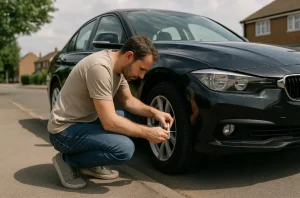
Tyres are the only part of your vehicle in direct contact with the road, making them critical for safe handling, braking, and fuel efficiency. In the UK, it’s a legal requirement to maintain your tyres in proper condition, not only to pass your MOT but also to stay road legal every day.
Worn or damaged tyres reduce grip, increase stopping distances, and significantly raise the risk of aquaplaning in wet weather. Even one illegal tyre can lead to a fine and penalty points on your licence, making regular checks essential for both safety and compliance.
Legal Tyre Requirements at a Glance
- Tread depth must be at least 1.6mm across the central three-quarters of the tyre.
- Tyres should be free from bulges, tears, or visible cords.
- All tyres must be correct for the vehicle’s specification (size and type).
- Pressure should be maintained as per the manufacturer’s recommendation.
- Mixing radial and cross-ply tyres on the same axle is not allowed.
- Each illegal tyre can result in a £2,500 fine and 3 penalty points.
How to Keep Your Tyres Road Legal?
Regular tyre inspections can help you avoid legal trouble and improve road safety. Check the tread depth monthly using a tread gauge or the 20p test.
Inspect sidewalls for cracks or swelling, and ensure even wear across all tyres. Keeping tyre pressure at the recommended level helps extend their life and improves fuel economy.
If your tyres are nearing the legal minimum or show uneven wear, have them replaced immediately. Tyre rotation every 6,000 miles and professional alignment checks also contribute to longer-lasting and compliant tyres.
2. Braking System and Its Legal Compliance

Your car’s braking system is one of the most vital safety features, and the law requires it to be in perfect working condition at all times. Faulty brakes can lead to extended stopping distances or complete brake failure, putting everyone on the road at risk.
A defective braking system can result in MOT failure, fines, or points on your licence. Therefore, keeping your brakes in top shape isn’t just smart maintenance — it’s a legal necessity.
What the Law Requires for Brakes?
- The brake pedal must be firm and responsive.
- Brakes must apply evenly across all wheels.
- The handbrake should hold the car on an incline without slipping.
- Brake fluid levels must be correct and uncontaminated.
- Components such as pads, discs, and drums must not be excessively worn.
- Brake warning lights must function properly.
How to Maintain a Legal Braking System?
Check your brakes regularly for signs such as squealing, grinding, or pulling to one side. If your pedal feels soft or travels too far, get the system inspected immediately.
Brake fluid should be changed according to your manufacturer’s service schedule, and worn pads must be replaced before they compromise braking effectiveness. Have your brakes tested during services and always respond quickly to warning lights or performance changes.
3. Headlights, Brake Lights, and Indicators

Vehicle lights are legally required to ensure safe visibility and communication with other road users. From turning signals to brake lights, every bulb on your car plays a role in preventing accidents, especially at night or during poor weather.
If even one light is not functioning correctly, it can result in a roadside fine or MOT failure. It’s not just about your own safety; it’s about helping others see and anticipate your actions.
Lighting Components You Must Maintain
- Headlights (both dipped and full beam)
- Front and rear indicators
- Brake lights that activate with pedal use
- Fog lights (where fitted)
- Number plate lights
- Rear lights and side repeaters
Keeping Your Vehicle’s Lighting Legal
Test your lights weekly by turning them on and walking around your car to check functionality. Replace faulty bulbs immediately using manufacturer-approved parts. Clean your light covers regularly to prevent reduced visibility due to dirt or oxidation.
If your headlights seem misaligned, have them professionally adjusted to avoid dazzling oncoming drivers or compromising your night vision.
4. Windscreens and Wipers
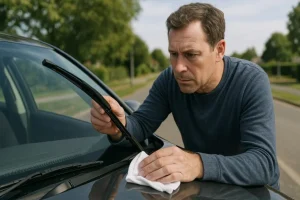
A clear windscreen is vital for maintaining full visibility of the road. UK law sets strict limits on windscreen damage, especially in the driver’s direct line of vision, and requires that wipers be capable of effectively clearing rain, snow, and debris.
Any defect that impairs visibility can make your car unroadworthy. Even a worn-out wiper blade or a washer that doesn’t spray can lead to an MOT failure or on-the-spot fine.
Windscreen and Wiper Legal Standards
- Damage must not exceed 10mm in the driver’s central view.
- Outside that area, cracks up to 40mm are acceptable.
- Wipers must clear the screen effectively without streaking.
- Washer jets must be functional and aimed correctly.
- The screen must not be excessively tinted or obscured.
How to Keep Visibility Within Legal Limits?
Inspect your windscreen often for chips or cracks. Small chips can usually be repaired if caught early. Replace wiper blades once they show signs of wear like streaking or skipping.
Keep washer fluid topped up with a suitable mix and clean your windscreen regularly, both inside and out. If visibility is compromised, address it before taking your car on the road.
5. Mirrors and Visibility Aids

Mirrors are legally required for maintaining a full view of surrounding traffic. If any of your essential mirrors are missing, cracked, or misaligned, you risk receiving a fine and compromising your ability to drive safely.
Modern vehicles may also include visibility aids like reversing cameras and blind spot monitors, while not all are required by law, primary mirrors certainly are.
Legal Mirror Setup for UK Drivers
- Driver’s side exterior mirror is mandatory.
- Interior rear-view mirror must be present unless blocked by vehicle design.
- Passenger side mirror is required for vans and most larger vehicles.
- Mirrors must be secure, adjustable, and provide an unobstructed view.
Staying Legal with Your Mirrors
Before driving, always adjust all mirrors to provide maximum coverage of blind spots. Replace cracked or broken glass immediately, temporary fixes like tape are not acceptable. Keep mirror surfaces clean and clear. If your vehicle has additional aids like cameras, ensure they function correctly and are not obscured by dirt or snow.
6. Seat Belts and Child Restraints

Seat belts are required by law for every seat in your vehicle. Failing to wear one, or having damaged belts, can result in a fine and in the event of a crash, could be fatal. You’re also legally responsible for ensuring child passengers are correctly restrained.
From lap belts to ISOFIX child seats, the law is clear: these safety components must be fully functional and used properly.
Legal Seat Belt and Restraint Rules
- Seat belts must be worn by all passengers unless medically exempt.
- Drivers are responsible for passengers under 14.
- Children under 135cm or 12 years must use a suitable child restraint.
- Belts must retract and lock properly and show no signs of fraying.
- Exemptions apply for reversing, taxi drivers, and certified medical cases.
Keeping Your Restraint System Road Legal
Inspect belts regularly for signs of wear or mechanical issues. Test the locking mechanism and retraction strength. Ensure child seats are age- and weight-appropriate, securely fastened, and meet UK safety standards. If you suspect a seat belt isn’t functioning as designed, replace it without delay.
7. Number Plates and Identification
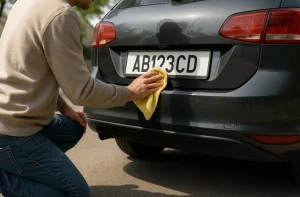
Number plates are essential for identifying vehicles legally on the road. If they’re obscured, faded, or altered, your vehicle may be flagged by cameras or stopped by police. You could face fines or have your vehicle deemed unroadworthy.
It’s not just about appearance, legal plate standards support law enforcement and vehicle recognition.
Legal Number Plate Guidelines
- Must be white (front) and yellow (rear).
- Font and spacing must comply with DVLA regulations.
- Cannot include background patterns or stylised fonts.
- Must be clean, flat, and clearly legible.
- Reflective and visible under low light.
How to Stay Compliant with Number Plate Laws
Clean your plates regularly, especially in winter. Avoid any decorative changes, including stickers or tinted covers. If a plate is cracked, faded, or illegible, replace it immediately through an authorised supplier. Fix loose plates firmly to prevent them from falling off.
8. Exhaust System and Emissions Standards

Your car’s exhaust system controls emissions and reduces noise. If your exhaust is damaged, missing components like the catalytic converter, or produces excessive smoke, it is not road legal and could fail its MOT.
With rising focus on environmental compliance, emission-related violations are taken very seriously.
What the Law Expects from Your Exhaust
- Must be securely attached and free from leaks.
- Emissions must fall within acceptable limits.
- Noise levels must not exceed legal thresholds.
- Catalytic converter must be present if required.
- No visible smoke from the exhaust pipe.
Maintaining a Compliant Exhaust System
Listen for unusual rattles or loud sounds, they could signal a leak or loose component. If your car starts emitting thick smoke or smells strange, get it inspected immediately.
Regular services help ensure the exhaust system, sensors, and emissions controls are functioning properly. Avoid tampering with emissions systems, as this is illegal and dangerous.
9. Steering Mechanism Requirements

Your car’s steering must offer consistent control, free from delay, stiffness, or drifting. Any fault can be dangerous and is grounds for MOT failure and roadside penalties.
It’s a system you depend on constantly, so the law demands it be in full working condition. Ignoring early signs of wear can lead to hazardous situations or complete steering failure
Steering Requirements to Pass Legal Standards
- Steering must respond promptly with no delay.
- There should be no excessive “free play” in the wheel.
- Power steering systems must not leak or malfunction.
- Steering components must be undamaged and correctly aligned.
How to Maintain a Legal Steering System?
If your steering feels loose, stiff, or pulls to one side, get it checked immediately. Check the power steering fluid regularly if your car has a hydraulic system. Address any warning lights or noises during turns. Annual servicing helps detect worn tie rods, bushings, or alignment problems early.
10. Suspension System and Safety Standards
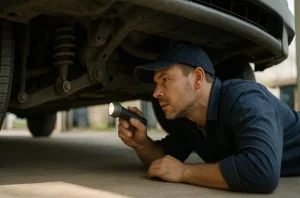
The suspension keeps your vehicle stable, absorbs road shocks, and helps your tyres maintain contact with the surface. If it’s worn or broken, it affects control and comfort, making the car unsafe and illegal to drive.
Even small suspension faults can lead to uneven tyre wear, poor handling, or sudden failure.
Legal Suspension System Guidelines
- Springs must be intact and correctly positioned.
- Shock absorbers should dampen effectively.
- There must be no excessive movement or sagging.
- Bushings and joints must not be worn or loose.
- MOT failures include leaking shocks or broken springs.
Keeping Your Suspension Roadworthy
Watch for signs like bouncing, dipping when braking, or an uneven ride height. Have your suspension inspected during regular services.
Avoid potholes and overloading, which accelerate wear. Replace worn components promptly to avoid MOT failure and compromised control.
Comparison Table – Legal vs Non-Legal Car Parts to Maintain
Understanding which parts of your vehicle you’re legally required to maintain versus those that are optional helps prioritise safety and compliance. While it’s always good practice to maintain your entire vehicle, only certain components are enforceable by law. The table below highlights key differences between legal obligations and general maintenance practices.
Legal vs Non-Legal Maintenance Requirements:
| Car Component | Legally Required? | Why It Matters |
|---|---|---|
| Tyres | Yes | Affects grip, stopping distance, and road safety. |
| Seat Belts | Yes | Essential for driver and passenger protection. |
| Lights & Indicators | Yes | Visibility and signalling to other road users. |
| Mirrors | Yes | Ensures full view of surroundings. |
| Windscreen & Wipers | Yes | Clear vision in all conditions. |
| Exhaust & Emissions | Yes | Compliance with environmental standards. |
| Number Plates | Yes | Legal vehicle identification. |
| Steering & Suspension | Yes | Controls stability and handling. |
| Gears & Transmission | No | Not driver’s legal responsibility. |
| Car Stereo / Infotainment | No | Convenience, not safety related. |
Solution: Prioritise legally required parts during maintenance. Optional components should still be inspected to maintain overall vehicle health.
Conclusion
Keeping your car in good condition isn’t just a recommendation, it’s the law. As a driver in the UK, you’re legally obliged to ensure essential components such as tyres, seat belts, lights, mirrors, and brakes are functioning correctly.
Neglecting these not only risks fines or points on your licence but endangers everyone on the road. Regular checks, prompt repairs, and scheduled services help you remain compliant and confident behind the wheel. Stay proactive, stay roadworthy, and you’ll stay on the right side of the law.
Frequently Asked Questions
What happens if my car fails the MOT due to a faulty part?
You cannot legally drive the vehicle until the fault is fixed unless you’re driving to a repair centre or MOT re-test.
Can I be fined for dirty number plates in the UK?
Yes, unreadable or dirty number plates can result in a fine as they must be clear at all times for legal identification.
Do I need to replace all my tyres at the same time by law?
No, it is not required by law, but all tyres must meet the legal tread depth and be free from damage.
Are cracked windscreens an MOT failure?
Yes, cracks larger than 10mm in the driver’s view or over 40mm elsewhere will fail an MOT.
Who checks car compliance with these legal conditions?
Compliance is checked during MOT tests, roadside checks by police, and inspections by DVSA officers.
Is it illegal to drive with a broken wing mirror?
Yes, if you have fewer than the required mirrors or poor visibility, you can be fined or fail an MOT.
Are seat belts in the back seats legally required to work?
Yes, all seat belts, including those in the rear, must be functional, and passengers under 14 are the driver’s responsibility.



